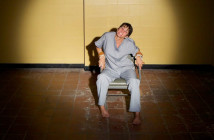This nine-year-old movie review of Pan’s Labyrinth was the first movie review I wrote for the Voice, Bloomsburg University’s student newspaper. A 22-year-old me wrote it, and while the style I wrote in then doesn’t match my style now, I’m still fond of the review…
The insatiable imagination of Ofelia leads her away from home in the middle of the night into the ancient decaying labyrinth in the woods nearby. Led by a fluttering fairy, she descends the spiraling stone staircase at the maze’s middle. It leads her below the earth, where Ofelia is confronted by the labyrinth’s caretaker. “I am the mountain, the forest, and the earth. I am a faun,” the otherworldly creature says to Ofelia in jittery movements. “[And] you’re Princess Moanna, daughter of the king of the underworld.” Despite Ofelia’s objections, the faun continues forward with his decree. “But we have to make sure that your essence is intact—that you have not become a mortal. You must complete three tasks before the moon is full.”
Pan’s Labyrinth provides audiences with a cinematic tale that’s as refreshing as it is imaginative. Being both dazzling and enchanting in vision and story, the dark tale will endure throughout film history. Conceived and directed by Guillermo Del Toro, best known for The Devil’s Backbone and the film adaptation of the gothic comic book Hellboy. But Del Toro’s recent release to theatres is easily his most stunning and captivating.
Pan’s Labyrinth carries viewers through a cinematic journey of two parallel story arcs during 1944, a few years after the end of the Spanish Civil War. The main arc involves the young and creative Ofelia, whose pregnant mother, Carmen, is moving her to live in the mill of her stepfather, Captain Vidal, as Carmen hopes to form a new family since the death of her first husband. The captain leads a small host of troops fighting for the Nationalists of General Francisco Franco. It’s at the mill where the captain keeps his small army as he battles against the rebel Republican militia.
Ophelia’s journey into a world of fantasy is set into motion when she discovers a fairy that leads her to the faun-like Pan. The creature gently commands the girl to carry out three tasks before the full moon to prove that she is the lost princess of the underworld kingdom Pan comes from. To guide her, she is given a book that shows her the duties she must fulfill.
Throughout Ofelia’s quests, the film reflects back to the grim reality of the world she’s desperately trying to escape. Her pregnant mother grows more and more ill as her child’s birth grows closer. The rebel militia’s attacks move closer and closer to the mill where the Nationalist troops are based. The ruthlessness of Captain Vidal becomes more apparent, leading audiences to the question of who’s the enemy versus who’s the hero.
While not focusing on the harshness of war and blood, the story explores ancient cursed trees and twisting intricate halls with Ofelia as she carries out her tasks to prove her royal blood. Throughout her adventures, she’s forced to confront a giant monstrous toad that holds within it a key needed to move her destiny forward. The eerie and chilling Pale Man guards over a grand temping feast that will challenge Ofelia to decided between obedience and desire. Ultimately, the girl’s morality and innocence will be confronted as she faces her most villainous opponent of all.
Pan’s Labyrinth never let’s up on the action and intrigue, nor does it ever let down with cliché or tired imagery. The film is visually lyrical—moving smoothly and enticingly as the plot unravels. With crisp sharp camera work, a strong convincing cast, amazing sets, and even more amazing creatures and monsters, the movie manages to impress on every level. Audiences are left with an array of emotions at the end of Pan’s Labyrinth—the juxtaposed worlds of dark fantasy and harsh reality smashing together in climax. The finale ultimately questions where the threads of imagination end and those of actuality begin.
This movie review originally appeared in the Voice, the student newspaper of Bloomsburg University, in February 2007.



